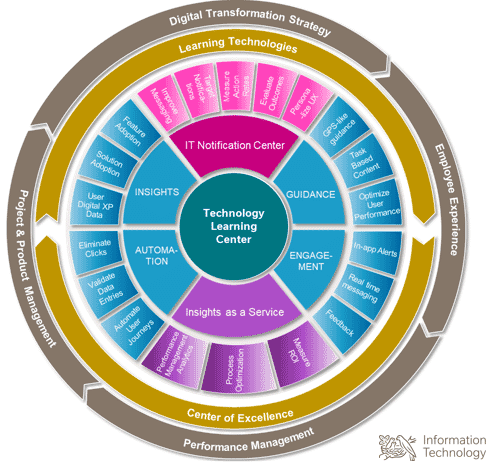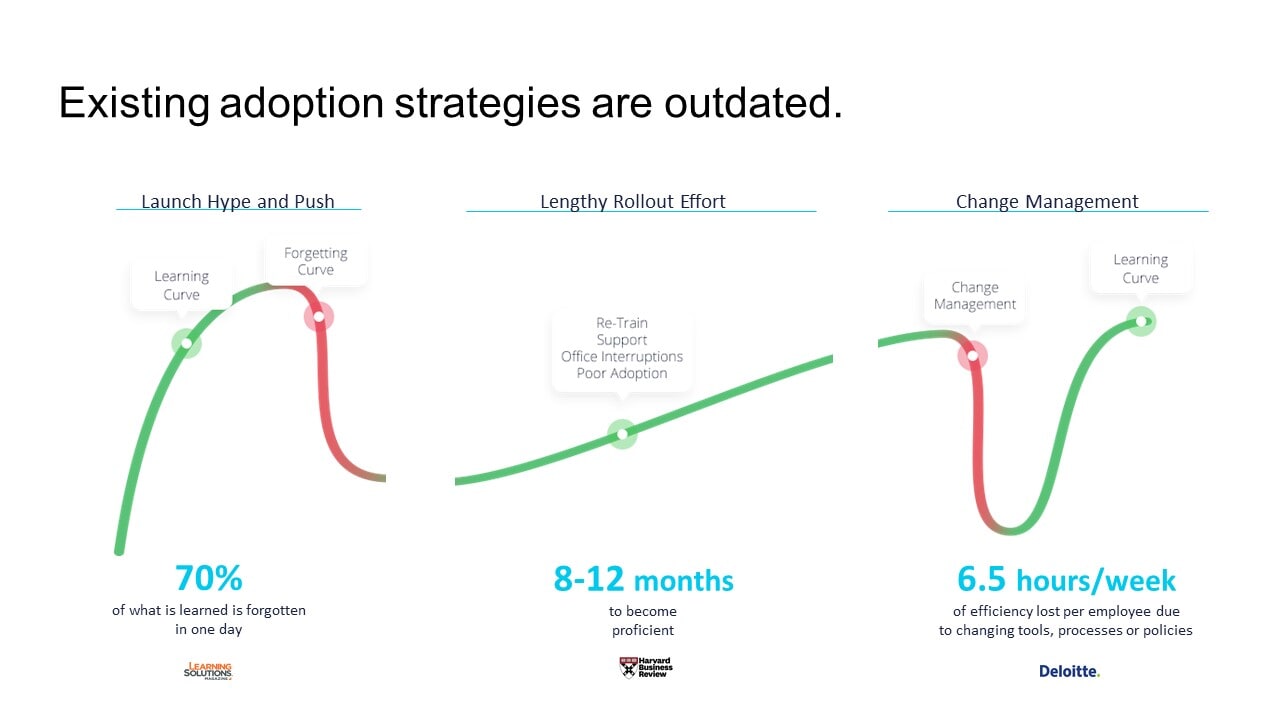This guest post was written by the Sr. Product Manager for the Nestlé Technology Learning Center, Greisy Flores. Since 2016, Greisy has worked with a dedicated team of learning and training professionals who develop innovative digital products for the purpose of increasing Employee Digital Dexterity.
Table of Contents:
- What is Digital Dexterity
- How Technology Has Changed Training in the Workplace
- How Technology Training Used in Training Employees Can Boost Performance
- The Benefits of Using AI in Training and Development
- Different Types of AI for Corporate Training
- AI-Powered Tools for Training
- Impacts of AI on Personalized Learning Experiences
- AI in Training Localization and Multilingual Support
What Is Digital Dexterity?
Digital dexterity is “the employees’ ability and ambition to embrace existing and emerging technologies to achieve better business outcomes.” – Digital Dexterity by the Numbers: The Most Impactful Ways to Build a Digital Dexterous Workforce. Published 16, Nov. 2018, Gartner CIO Research Team.
We didn’t call it digital dexterity in 2016, but there were a lot of workplace training groups in existence that cultivated digital skills, culture and competencies. As the Technology Learning Center, we set out to complement the work of other technology-based training groups rather than just replicating it. Furthermore, we saw a need for a different strategy, and we wanted to create a paradigm shift; we would work on making technology people literate, rather than making people technology literate.
Nestlé Technology Learning Center Approach
Our approach is to use a series of digital products to engage with our employees at the point of need. Our training method integrates the learning experience into the application using a Digital Adoption Platform. And, we provide access to relevant information created in MadCap Flare; where we develop, manage and publish content in several formats, such as online, desktop, and mobile.
When we first launched the Technology Learning Center, we ran across several challenges:
- We had to consider how to create a learning program that was both new and engaging, which required a new mindset regarding when learning happens most effectively — away from the classroom and in the workflow.
- We had to find learning and development solutions and technologies that would help us build this new learning approach.
- We had to develop new skills within the team.
We started with an initiative to educate IT Product Managers with use cases and the purpose of Performance Support; when and where it’s appropriate and how we go about using it.

To drive a global program across hundreds of applications we needed user-generated content. We trained subject matter experts to manage the scope of work and make learning solutions more relevant to the end-user. This meant using technologies that are easy for anyone to use to create, edit and publish content.
And finally, for Product Managers and Solution Owners who are responsible for ensuring the adoption of their solutions and realizing the value they bring to the organization, the Technology Learning Center became a Center of Excellence that guides the implementation of user-centric training and digital adoption solutions.
How Technology Has Changed Training in the Workplace
As you can imagine, technology plays a major role in the solutions that we deliver. Just as technology has changed the way people collaborate, it has also changed the way people learn.
For example, online training content and animated videos make every training process accessible, engaging and convenient. Up until recently, you needed intense technical skills as well as expensive and complicated technology to edit and publish these types of videos. Now, anyone with a smartphone can create, edit and upload a high-quality video to YouTube or an internal site within a matter of minutes.
Another game-changer is the Digital Adoption Platform (DAP). A DAP is a technology layer that sits across different applications to ensure faster and simpler execution and adoption.

DAPs include four functional elements:
- Digital experience analytics
- In-application guidance
- Active user engagement
- Process automation
Digital Adoption Platforms such as WalkMe, allow us to collect and analyze usage data, gain visibility into the learner journey and find out where our users struggle so that we can make data-driven decisions about what kind of training material to create and where to best publish it.
The digitalization of learning content is often overlooked or underestimated. We created a digital learning strategy to create and transform content so that it maximizes its impact, enables better decision-making, and delivers a better user experience. We started by treating content as an asset and establishing content governance across all of our solutions. Once again technology-based training and AI in learning and development plays a key role in achieving our goals. We use an AI-powered platform called Acrolinx to:
- Unify different teams under one voice and one communication guideline.
- Give our writers immediate feedback as they create content.
- Save valuable time editing content.
- Adjust the clarity, terminology, and formality of our content depending on who we are speaking to.
- Ensure our message sounds consistent throughout the entire learning journey.
And, we use MadCap Software solutions to support the Technology Learning Center content development processes:
- Authoring, publishing, and translation of our IT Learning Center.
- Streamline content delivery and maximize content reuse.
- Establish content ownership.
- Encourage anyone to review and contribute content.
- Reduce costs and increase localization/translation efficiency.
- Provide user analytics on our content and use insights to improve how users interact with and consume our content.
How Technology Used in Training Employees Can Boost Performance
There are countless articles on the internet regarding failed digital transformation efforts. All of these articles highlight the lack of digital adoption as a key reason for failure. Simply put, unless people can use this new technology as it was intended; it is impossible to fully realize the value of digital initiatives.
Unfortunately, the average employee is overwhelmed with the number of applications required on the job. Add to that the challenges of training and development, plus the rapid rate of agile development cycles, makes it nearly impossible for people to keep up with multiple applications. The results are low employee engagement, increased confusion, and errors that reduce productivity. Instead of helping, this new tech becomes a barrier to productivity and innovation instead of an enabler.
Change management can still address the mindset and cultural changes, but a traditional employee training method is simply unable to address today's digital challenges.

Moreover, it is for this reason that Learning and Training organizations should require investment to augment current infrastructure to include new learning and training technology, methodologies, and professionals. This new technology used in training employees is the missing layer to the challenges with digital dexterity as organizations look to make the digital, modern workplace a reality. Whether dealing with customers, an internal department or existing employees, training and employee development have significant effects on user adoption, profit growth, and overall company sustainability.
The Benefits of Using AI in Training and Development
In today's rapidly evolving business landscape, the integration of artificial intelligence or AI in training and development has become increasingly crucial. As organizations strive to enhance employee skill sets and bridge the skill gap, AI offers transformative solutions. This article provides an in-depth exploration of the benefits and different types of AI in corporate training.
Enhancing Learning Efficiency and Effectiveness
In the realm of corporate training, one size does not fit all. AI empowers organizations to deliver a personalized learning experience tailored to individual needs. By analyzing vast amounts of data, AI algorithm varieties identify learners' strengths, weaknesses, and learning preferences. This enables the creation of adaptive learning path options that cater to each individual, maximizing learning efficiency.
Moreover, AI facilitates faster learning processes through adaptive learning algorithms. These algorithms leverage machine learning and deep learning techniques to dynamically adjust the training curriculum based on learners' progress and performance. This adaptability ensures that learners receive the right content at the right time, accelerating their mastery of essential AI skills.
AI also plays a pivotal role in bridging the skill gap with targeted training program varieties. By collecting and analyzing training data, AI algorithms identify areas where employees lack proficiency. With this information, organizations can develop tailored training initiatives that address specific skill gaps, empowering employees to upskill and meet the demands of an AI-driven future.
Improving Training Content and Delivery
AI-powered tools revolutionize the creation and delivery of training content. Through the use of generative AI, organizations can convert text into engaging video content. By automating the process of video creation, AI tool selections save time and resources, enabling organizations to scale AI training initiatives effectively.
Furthermore, AI-generated written content enhances training material types. AI algorithms can analyze vast amounts of data and generate high-quality content that is accurate, concise, and tailored to the training objectives. This streamlines the content creation process, empowering organizations to deliver up-to-date and relevant training materials to their employees.
AI also enhances training videos through various technologies. Natural language processing enables efficient content understanding, facilitating automated transcription, subtitling, and indexing. Additionally, AI-powered tools can enhance training videos with features such as automatic scene recognition, sentiment analysis, and interactive elements, fostering an engaging and impactful learning experience.
Different Types of AI for Corporate Training
Machine Learning and Deep Learning
Machine learning forms the foundation of AI in corporate training. By leveraging machine learning algorithms, organizations can analyze vast amounts of training data to gain valuable insights. These insights enable the creation of data-driven training programs, ensuring that employees receive relevant and targeted learning experiences.
A deep learning model further enhances training by enabling advanced pattern recognition. Through neural networks, deep learning algorithms excel at understanding complex data structures, such as images, speech, and natural language. This enables the development of immersive and interactive training experiences that simulate real-world scenarios, enhancing knowledge retention and practical application.
Natural Language Processing and Chatbots
Natural language processing (NLP) plays a crucial role in AI-driven training. NLP enables chatbots to provide interactive and engaging training experiences. AI-powered chatbots act as virtual trainers, answering learners' questions, providing guidance, and facilitating knowledge transfer. Learners can interact with chatbots in a conversational manner, fostering a personalized and efficient learning environment.
Moreover, NLP enables efficient content understanding, enabling automated analysis and categorization of training materials. This allows organizations to organize and deliver training content effectively, ensuring that learners can access relevant information quickly and easily.
Virtual Lecturers and Virtual Assistants
AI-driven virtual lecturers revolutionize training delivery. With the ability to scale training efforts across a large workforce, virtual lecturers provide personalized and tailored learning experiences. Through adaptive learning algorithms, virtual lecturers adjust their teaching approaches based on individual learners' progress, strengths, and areas for improvement.
Virtual assistants, powered by AI, offer real-time guidance and support during training sessions. These assistants can provide instant feedback, answer questions, and guide learners through complex topics. Learners can interact with virtual assistants as if they were interacting with human trainers, promoting engagement and facilitating effective learning.
AI-Powered Tools for Training
Chatbots for Training Assistance
An AI chatbot can serve as invaluable virtual trainers, assisting learners throughout their training journey. These chatbots can answer learners' questions, provide explanations, and offer real-time support. By leveraging AI algorithms and natural language processing, chatbots create interactive and immersive training simulations, enabling learners to apply their knowledge in practical scenarios.
AI in Content Generation
Generative AI transforms the content creation process by automatically generating training materials and exercises. AI algorithms analyze vast amounts of data and generate content that is accurate, engaging, and tailored to the specific training objectives. This automated content generation saves time and resources while ensuring that training materials are up-to-date and aligned with the organization's goals.
AI for Language Translation in Training
Different AI system types play a critical role in translating training materials into multiple languages, facilitating global training programs. AI models analyze and process training content, ensuring accurate translation while preserving contextual meaning. This streamlines the localization process and enables organizations to deliver training materials in learners' native languages, promoting inclusivity and accessibility
Impacts of AI on Personalized Learning Experiences
Adaptive Learning Path
AI algorithms create adaptive learning paths based on learners' skills and goals. By analyzing individual performance, AI algorithms recommend tailored learning resources, such as courses, modules, or microlearning content. This personalization ensures that learners receive the most relevant and effective training materials, optimizing their learning journey.
Additionally, AI systems track learners' progress and provide real-time feedback. Learners can monitor their performance, identify areas for improvement, and receive personalized recommendations for further skill development. This continuous feedback loop fosters a culture of continuous learning and improvement.
Enhanced Learner Engagement
AI technologies enhance learner engagement through interactive and gamified learning experiences. By incorporating elements such as gamification, simulations, and virtual reality, organizations create immersive training environments that captivate learners' attention and foster active participation. AI-powered feedback and assessments provide learners with immediate insights and encourage continuous improvement.
Skill Development and Upskilling
AI-driven simulations and scenarios enable practical skill development. By simulating real-world situations, learners can apply their knowledge and practice skills in a risk-free environment. This hands-on experience enhances skill development, ensuring that learners are equipped with the necessary competencies for their roles.
AI algorithms also play a vital role in identifying skill gaps and recommending relevant training courses. By analyzing training data and individual performance, AI systems provide insights into areas where employees need further development. This empowers organizations to offer targeted training programs, addressing specific skill gaps and facilitating upskilling initiatives.
AI in Training Localization and Multilingual Support
AI for Training Material Translation
AI models streamline the translation of training materials into multiple languages. By leveraging AI-powered language models, organizations can ensure accurate translation while preserving contextual meaning. This simplifies the localization process, enabling global training programs that cater to learners from diverse linguistic backgrounds.
AI in Multilingual Training Delivery
AI-driven virtual assistants offer multilingual support during training sessions. These virtual assistants can provide real-time translation and interpretation services, ensuring that learners can fully comprehend the training content regardless of language barriers. Real-time language translation using AI technology promotes inclusivity and enables organizations to deliver consistent training experiences across a global workforce.
Conclusion
The integration of AI in training and development holds tremendous potential for organizations seeking to enhance learning efficiency, bridge the skill gap, and deliver personalized learning experiences. From machine learning and deep learning to natural language processing and chatbots, AI-powered tools transform training content creation and delivery. With the ability to generate adaptive learning paths, enhance learner engagement, and facilitate skill development, AI revolutionizes the training landscape. Embracing AI in corporate training enables organizations to stay ahead in an ever-evolving business landscape, fostering a skilled and future-ready workforce.
This guest blog post was originally published on January 14, 2021, and updated on August 23, 2023.
Sources:
Baer, S. (2023) Council post: How to incorporate Artificial Intelligence into learning and development, Forbes. Available at: https://www.forbes.com/sites/forbeshumanresourcescouncil/2023/03/28/how-to-incorporate-artificial-intelligence-into-learning-and-development/ (Accessed: 20 July 2023).
Grieve, P. (2023) Deep Learning vs. machine learning: What’s the difference?, Zendesk. Available at: https://www.zendesk.com/blog/machine-learning-and-deep-learning/ (Accessed: 20 July 2023).
Harve, A. (2023) The role of Artificial Intelligence in learning and development, Hurix Digital. Available at: https://www.hurix.com/role-of-artificial-intelligence-in-learning-and-development/ (Accessed: 20 July 2023).
Kasparova, K. (2023) Why and how to use AI for training and development in 2023, in 2023. Available at: https://www.synthesia.io/post/why-and-how-to-use-ai-for-training-and-development (Accessed: 20 July 2023).
Loutfi, E. (2023) The future of L&D: How ai is Revolutionizing Talent Development, Chief Learning Officer. Available at: https://www.chieflearningofficer.com/2023/03/20/the-future-of-ld-how-ai-is-revolutionizing-talent-development/ (Accessed: 20 July 2023).
Lutkevich, B. (2023) What is natural language processing? an introduction to NLP, Enterprise AI. Edited by E. Burns. Available at: https://www.techtarget.com/searchenterpriseai/definition/natural-language-processing-NLP (Accessed: 20 July 2023).
Pavlou, C. (2023) Artificial Intelligence in training: Unlocking the benefits of AI: Talentlms, TalentLMS Blog. Available at: https://www.talentlms.com/blog/artificial-intelligence-in-training/ (Accessed: 20 July 2023).
Wallace, D. and Yordanov, B. (2023) 10 immediate uses for AI in learning and development: ATD, Main. Available at: https://www.td.org/atd-blog/10-immediate-uses-for-ai-in-learning-and-development (Accessed: 20 July 2023).











